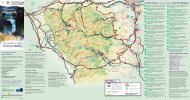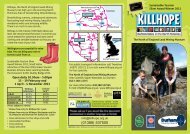How a visit to Killhope can inspire
How a visit to Killhope can inspire
How a visit to Killhope can inspire
You also want an ePaper? Increase the reach of your titles
YUMPU automatically turns print PDFs into web optimized ePapers that Google loves.
UNIT 11: WHAT WAS IT LIKE FOR CHILDREN LIVING IN VICTORIAN BRITAIN<br />
Using <strong>Killhope</strong>: <strong>Killhope</strong> is an excellent site <strong>to</strong> support this unit, as Vic<strong>to</strong>rian children lived and<br />
worked here and have left evidence. It also allows children <strong>to</strong> carry out tasks Vic<strong>to</strong>rian children<br />
would have done, and <strong>to</strong> experience living conditions as they would have. <strong>Killhope</strong>’s main strength<br />
for this module is in providing the information and the real life context children will need <strong>to</strong> complete<br />
many of the learning objectives and outcomes, rather than in enabling them <strong>to</strong> carry out the<br />
recommended activities on site.<br />
Our Resource Box contains further games and past-times children <strong>can</strong> play.<br />
LEARNING OBJECTIVES POSSIBLE ACTIVITIES LEARNING OUTCOMES<br />
• To consider what life was<br />
like for children in the past.<br />
Who are the Vic<strong>to</strong>rians and when did they live?<br />
• Ask the children <strong>to</strong> place<br />
the Vic<strong>to</strong>rian period on a<br />
timeline.<br />
• Discuss with the children<br />
whether all children would<br />
have had similar lives.<br />
Look at the living<br />
conditions of the children<br />
who worked in the mine.<br />
What was life like for a poor child in the 1840s?<br />
• Can place the Vic<strong>to</strong>rian<br />
period on a timeline.<br />
• Suggest what life was like<br />
for children living in the<br />
past.<br />
• To collect information from a<br />
range of sources and draw<br />
conclusions about Vic<strong>to</strong>rian<br />
life.<br />
• To understand that ways of<br />
life differed greatly across<br />
Vic<strong>to</strong>rian society.<br />
• To write a narrative using<br />
his<strong>to</strong>rical detail.<br />
• To understand that there are<br />
many representations of the<br />
Vic<strong>to</strong>rian period.<br />
• Discuss possible sources<br />
of information about life for<br />
the poor in the nineteenth<br />
century.<br />
• Discover the sorts of jobs<br />
children did on the<br />
Washing Floor. Play the<br />
games they would have<br />
played, Use some of the<br />
documents in the<br />
Resource Boxes, such as<br />
‘Not in front of the<br />
servants’ and account of a<br />
young girl in service. Ask<br />
the children <strong>to</strong> make a list<br />
of what they <strong>can</strong> infer<br />
about the life of poor<br />
children from the sources<br />
and present it <strong>to</strong> the class.<br />
• Take a <strong>to</strong>ur of the site <strong>to</strong><br />
discover the numbers of<br />
working children, their<br />
hours of work, the types of<br />
jobs they did and their lack<br />
of education. Discuss why<br />
children worked in<br />
Vic<strong>to</strong>rian times.<br />
• After our mine trip, ask the<br />
children <strong>to</strong> imagine they<br />
are a Vic<strong>to</strong>rian child<br />
working in a lead mine and<br />
• List a number of aspects<br />
of daily life for poor<br />
Vic<strong>to</strong>rian children.<br />
• Produce a simple<br />
narrative <strong>to</strong> illustrate what<br />
they know about the work<br />
done by Vic<strong>to</strong>rian children.<br />
22







